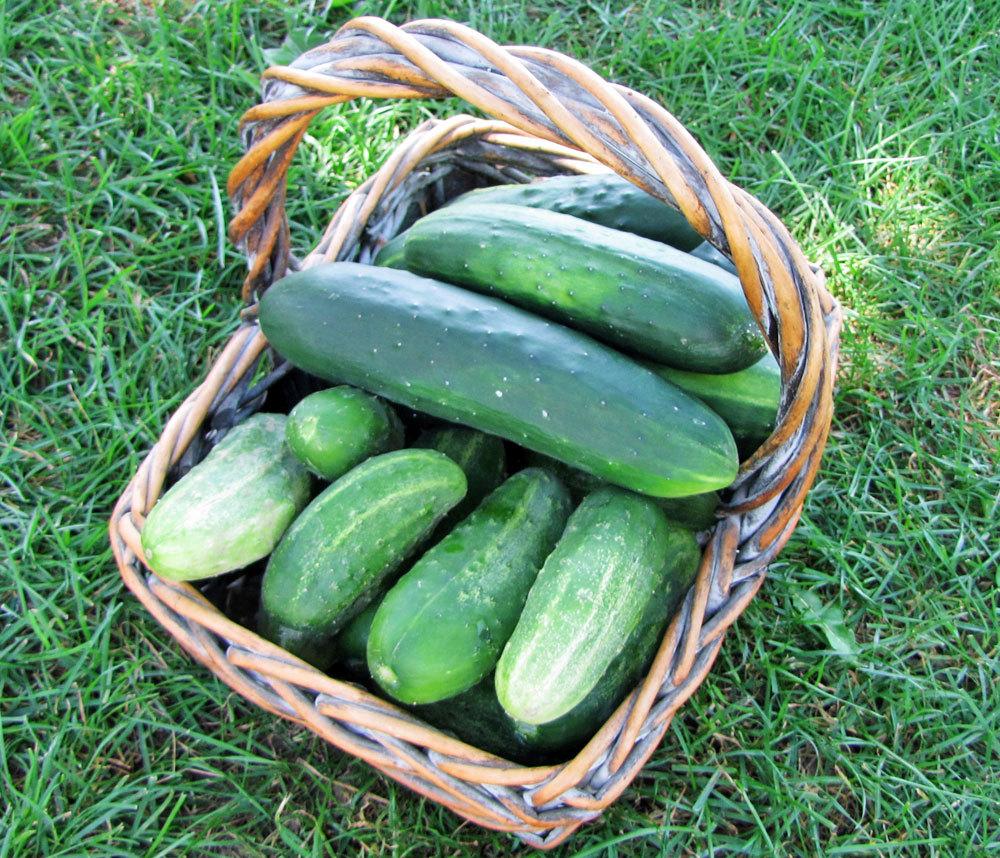What would a summer salad be without the cool crunch of cucumber slices? And winter would seem mighty long without some homemade pickles to remind us of our garden's summer bounty. It's no surprise that cucumbers are one of the top five home garden veggies. And even if you don't have any ground to garden in, cucumbers adapt well to container culture, so just about everyone can enjoy a harvest of homegrown cukes!

Monoecious or Gynoecious?
Open-pollinated varieties of cucumbers are old standbys and include the interesting ones with unusual colors and shapes. Hybrid cucumbers may bear more heavily and show greater resistance to some of the diseases that can trouble this crop.
Typically, cucumber vines produce separate male and female flowers on the same plant. Bees carry pollen from the male blossoms to the female blossoms in order for fruits to form.The term for these types of cucumbers is "monoecious."
But among the hybrids, you may see varieties labeled "gynoecious." These cukes only produce female flowers. Since every flower can produce a fruit, they bear especially big crops. In addition, these varieties have the broadest range of disease resistance. However, you do need to plant a monoecious variety that bears male flowers nearby in order to provide the pollen needed for fertilization. These types of cucumbers usually have some seeds of pollinator vines included right in the seed packet. Just be careful when you are thinning direct-sown seeds to leave some monoecious seedlings.
Tips for Growing Cucumbers
Sow Seeds When Warm Weather Arrives
While its name may evoke the epitome of coolness, cucumber plants like it warm. Sow seeds directly in the garden when all danger of frost is past and the soil is at least 60 degrees F; 70 degrees is even better.
Get a Head Start in Short Season Climates
Plants can be started indoors 3-4 weeks before your setting out date. Be sure not to start them indoors any earlier than this, however, as older plants don't tolerate transplanting well. And be sure to start seedlings in individual, plantable pots (like peat pots) to minimize root disturbance at planting time.
Plant in Well-Prepared Soil
Cucumbers grow best in rich soil that has been amended with compost or well-rotted manure. Plant seeds in row or hills, depending on how you plan to support the vines. When planting gynoecious varieties, include one monoecious plant for every seven or eight gynoecious plants for good pollination. Mulch to conserve soil moisture.
Provide Support
Although it is not absolutely necessary to support vines on some sort of trellis, if you do you'll get straighter, easier to pick fruits, save space, and have fewer disease problems to deal with. The vines cling by tendrils to supports. Tepees or vertical or A-frame trellises work well. Be sure to put the support in place before you plant your seeds.
Plan for Pest Control
Cucumber beetles are small yellow-green beetles with either black spots or stripes on their backs. They begin feeding in early spring on the leaves and stems of cucumbers and related plants; a heavy infestation may totally destroy plants. The eggs they lay hatch into white grubs that can stunt plants by feeding on their roots. In addition to the direct damage they do, the beetles can spread bacterial wilt and mosaic virus, two diseases that can harm or even kill plants.
One of the best ways to control these pests is to rotate the location of cucumbers and their kin (squash, melons, pumpkins) in the garden and cover seedbeds or transplants with floating row covers immediately at planting time. You'll need to remove the covers when plants begin to bloom to allow bees in to pollinate, but covering helps to minimize damage to plants at the vulnerable seedling stage. Use a registered insecticide to control heavy infestations on uncovered plants.
Water Consistently
Cukes are mostly water, and a consistent supply of water will give the best harvest. Moisture stressed cukes may be bitter and misshapen. Drip irrigation and mulch both help reduce the possibility of water stress.
Harvest Regularly
Watch to see when the flower falls off the blossom end of the developing fruit -- you can start picking any time after that. Most pickling cukes are harvested when they are 2 to 4 inches long; most slicers are best at 6-8 inches.
 Victory Seed Company has all the seeds you want for your best garden in 2024.
Victory Seed Company has all the seeds you want for your best garden in 2024.
For 25 years, the family-owned Victory Seed Company has provided the highest quality vegetable, herb and flower seeds to families across the country. We are passionate about providing you the best seeds available that give excellent germination, robust plants, and the harvest you want. With a catalog of over a thousand varieties, we have everything, and our prices are the kinds that we'd want to pay. We have hundreds of yesterday's heirloom vegetables, as well as today's award winning hybrid selections. Get to know us by visiting our website and browsing through our online vegetable seed catalog.